If you wonder what chamomile is good for, what are the most important chamomile uses for illnesses, and how chamomile benefits your health, keep reading. You will also learn how to make chamomile tea and chamomile benefits for skin, sleep anxiety, and much more.
Chamomile (Matricaria chamomilla) is the one medicinal herb that was never missed from our home. Ever since we were kids, my mother and grandmother used chamomile for basically everything! Chamomile was the go-to natural remedy for a cold, a puffy eyes, and skin irritations, you name it. Still, up to this day, chamomile tea never misses from my pantry. There is even more to this wonderful plant than most of us know.

Chamomile has tones of health benefits and uses
There are a lot of home remedies with chamomile that you can make at home because the chamomile uses for health are tremendous in number. Without further ago, let’s get into the most important chamomile uses and health benefits. But first.
In This Article You Will Find:
Chamomile Uses in History
The greatest Antiquity doctors, Hippocrates, Dioscorides, and Pliny considered chamomile the universal treatment for every condition. Pliny had full confidence that chamomile was a sure remedy for snake bites, kidney stones, and cleansing the woman’s womb. During medieval times, nuns cultivated chamomile extensively all around the monasteries.
But did you know that chamomile has its origins in Ancient Egypt?
Egyptians praised its healing effects, and they associated chamomile with the Sun god Ra. Modest in appearance, chamomile has a special scent and miraculous healing powers. From the times of the Celts to the present day, chamomile has been a viable cure for vaginal discharge and skin irritations.
How to Harvest Chamomile
Chamomile flowers are harvested from May to August. The best time of the day to harvest chamomiles is in sunny and dry weather. You can dry chamomile flowers in a well-ventilated attic, and spread them on paper in thin layers. After they dry, flip them once to prevent mold and rot.

What Is Chamomile Good For? 8 Chamomile Uses
As I was saying, chamomile is a panacea herb, used for its many health benefits. These are the most important chamomile uses for health.
1. Chamomile Uses for The Stomach & Bowel
- Crohn’s Disease
- IBS
- gastroenteritis (infectious diarrhea)
- chronic gastritis
- duodenal ulcers
- colitis
- hemorrhoids
- constipation
- diarrhea
- intestinal cramps
- stomach pain
- high stomach acid
- indigestion with gas and/or bloating
- flatulence caused by stress
- slow digestion
- baby cramps
2. Chamomile Uses for Mouth, Throat, Eye Health
- Mouth: toothache, oral mucous inflammation, canker sores, stomatitis, gingivitis, dental abscess
- Throat: sinusitis, rhinopharyngitis, bronchitis, catarrh
- Eyes: conjunctivitis, eye inflammations, eyelids inflammations, eye pain, dark circles, puffy eyes
- Ears: ear inflammation, poor hearing
3. Chamomile Uses for Genital Conditions
- Women: menstrual cramps, lack of menstruation
- Men: orchitis (testicle inflammation), epididymitis, bacterial infections, etc
4. Chamomile Uses for Urinary Tract Health
5. Chamomile Uses for Skin
- eczema
- dermatitis
- neurodermatitis
- insect bites
- feet mycosis
- cracked nipples from breastfeeding
- skin cracks
- skin itch
- hot water/liquid skin burns
- excess sebum
- cellulite
- stretch marks
- baby diaper rash
6. Chamomile Uses for Beauty
- dry & dull hair with no shine
- roots fortifier (for blond and brow hair especially)
- juvenile acne
- dark circles
- face tonic
- natural makeup removal
7. Chamomile Uses for Anxiety, Insomnia & Depression
8. Other Chamomile Uses for Health
- fever
- radiation therapy recovery
- wound pains
- rheumatic pain
- limb paralysis
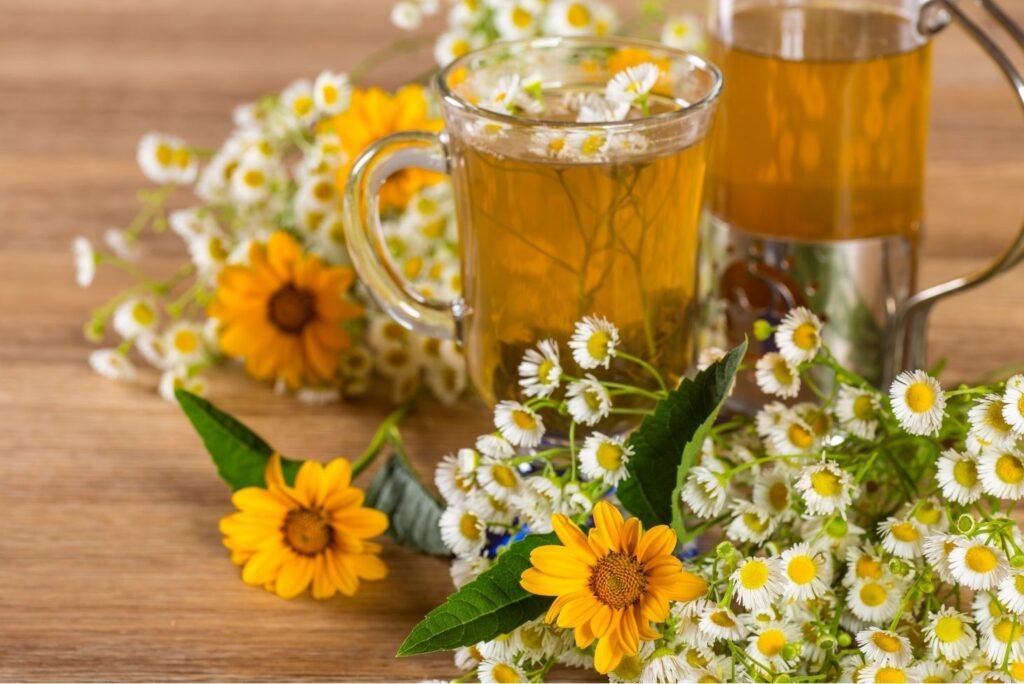
Chamomile Uses & Medicinal Properties
- Antispasmodic. Chamomile contains 2 water-soluble compounds: apigenin and bisabolol. They act similarly to the opium alkaloid papaverine. This is why chamomile is a natural alternative to conventional antispasmodic drugs.
- Anti-inflammatory. The flavonoids in chamomile flowers block the action of arachidonic acid. This acid is responsible for muscle tissue inflammations.
- Anti-allergic. Chamomile flowers contain something called azulenes. It is an organic compound that prevents histamine accumulation in the tissues. It activates the pituitary and adrenal glands to release cortisone to prevent allergic reactions, even acute ones.
- Tissue regeneration. Chamomile supports tissue scarring, including post-chemo lesions.
- Sedative. This wonder plant also contains apigenin, which is an organic compound that acts as a binder to the central benzodiazepine receptors. Yes, it is true, chamomile tea is a natural sleep aid.
- Mild laxative
- Anti-bacterial
- Antifungal
- Antiseptic
- Anti-diarrheal
- Anti-tumoral
10 Chamomile Uses for Illnesses & Medicinal Recipes
In her best-seller “Health Through God’s Pharmacy“, naturopath Maria Treben explains how to use chamomile. She even offers exact chamomile recipes for internal and external uses. Here are her famous chamomile recipes. Let’s begin with the famous chamomile tea.
1. How to Make Chamomile Tea
Scald 1 heaping tsp of chamomile flowers in 1 cup of water (1/4 L). Let the tea steep for 3 minutes. Drink 3-4 cups/day, while hot. For topical use, make a more concentrated chamomile tea, as follows. Add 2 heaping tbsp of chamomile flowers to 200 ml of hot water. Infuse for 5 minutes and strain. You can use chamomile tea externally in 3 ways:
- Chamomile Tea Gargles – great for throat inflammations and ORL issues.
- Poultice – for dermatitis, neurodermatitis, hemorrhoids, anal fissures, perianal fistulas, and nipple cracks from breastfeeding.
- Vaginal Washes – for inflammatory genital conditions, leucorrhea, etc.
Concentrated chamomile tea is great for eye inflammations, cracked skin, feet fungus, and eczema. Prepare the chamomile tea following the recipe above, but let it steep for 15 minutes. Use this tea to pad the eyes or as a poultice, or use it to wash the affected skin areas.
Chamomile Tea for Skin Repair
Make the same tea, but this time boil the chamomile flowers for 5 minutes. By boiling the chamomile flowers we help them activate their antibiotic effects. You can use this chamomile infusion for hot water skin burns.

What is Chamomile Tea Used For?
- Digestion: cramps, diarrhea, constipation, bloating, gas, indigestion, nausea, stomach ulcer, gastritis, etc
- Better sleep: insomnia, restless sleep, etc.
- Depression & anxiety.
- Menstrual cramps, estrogen imbalances, and other related issues.
- High blood sugar, and diabetes.
- Osteoporosis in women.
- Fights inflammation in the body caused by bacteria or fungi: skin, ear, eyes, genital, etc.
- Protects the heart by reducing blood pressure, and regulating cholesterol.
- Skin problems: eczema, skin irritations, dermatitis, hemorrhoids, etc.
- Liver health: jaundice, liver pain.
2. Chamomile Body Baths for Insomnia & Anxiety
This is how to make a chamomile body bath at home. Scald 4 fistfuls of chamomile flowers in a pot of water. Let the chamomile infuse really well for 5-10 minutes so that all the goodies are released into the water. Strain the infusion and add the water to your bathwater. Chamomile baths are great for:
- stress and anxiety
- insomnia
- eczema and skin issues
- hemorrhoids
- anal fissures and perianal fistulas
This is how to make a chamomile face and hair wash. Scald 1 fistful of flowers and do the same as for the bathwater. Pour the chamomile-infused water into a basin and wash your face and hair. The chamomile hair wash is for blonde and brown hair because it can lighten up the color tone of the hair.
3. Chamomile Massage Oil for Neuralgia
This is how you make chamomile oil at home. Fill up a jar with freshly picked chamomile flowers, up to the top, but don’t stuff them down. Fill the rest of the jar with cold-pressed olive oil, so that the flowers are fully covered. Seal the jar tight and place it in direct sunlight for the next 14 days. After 14 days, the chamomile oil is ready. Strain and keep the chamomile oil in the fridge, in a dark-colored glass bottle. Chamomile oil is great if you suffer from:
- neuralgia or pain
- skin rashes
- allergic skin reactions
- hemorrhoids
You can also use it for ear inflammations by adding 2-3 drops in each ear, twice a day. This is one of the unpopular chamomile uses, but absolutely amazing.
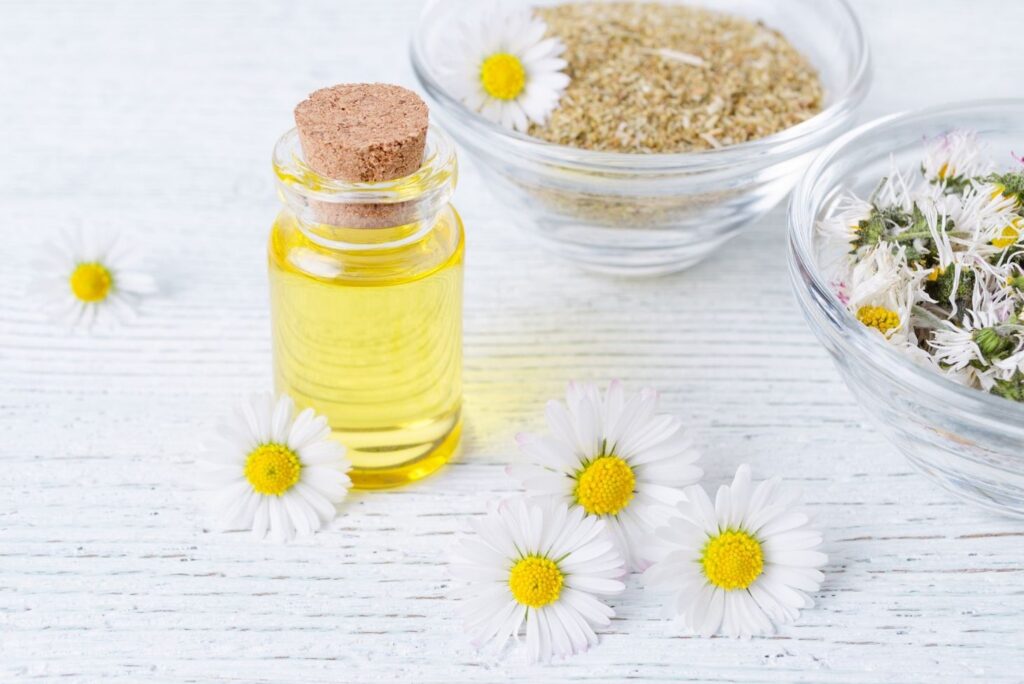
4. Chamomile Balm Recipe for Dermatitis
For the chamomile balm recipe, you need 2 ingredients: 2 handfuls of fresh chamomile flowers and 200 g of pork fat. Add the chamomile to the heated pork fat in a pan. The flowers will start to boil and foam. Stir well, then cover the pot with a lid. Keep it in a cool place overnight. The next day, heat up the balm slightly, just to be able to strain it. Use a linen towel to strain the balm. Pour the obtained chamomile balm into small dark jars. Store in the fridge. Chamomile balm is great for:
- dermatitis
- neurodermatitis
- rheumatic pain
- sprains
- sciatica pain
- hemorrhoids
- open wounds
- acne,
- boils, skin irritations
5. Chamomile Milk Poultice for Eye Inflammation
Boil 1 cup of milk (1/4 L). Pour it over 1 heaping tbsp of chamomile flowers, while hot. Infuse 1/2 to 2 minutes maximum. Strain and use it for warm/lukewarm poultices. This chamomile poultice is especially effective for:
- eye inflammations
- eye pain
- dark circles
- tired eyes
- puffy eyes
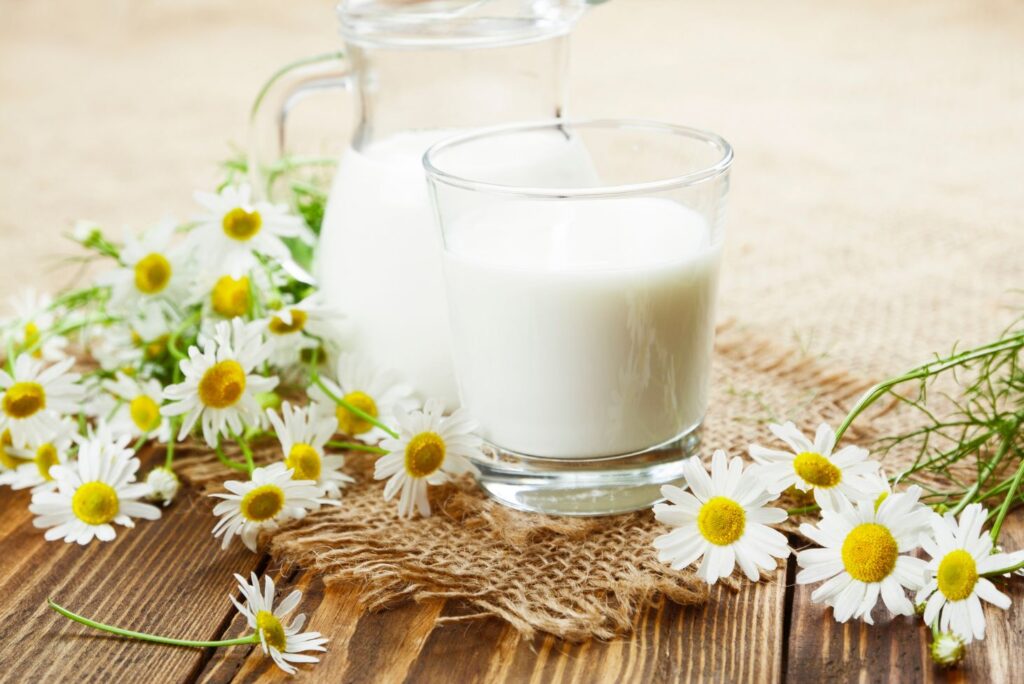
6. Chamomile Steam Inhalation for Respiratory Issues
Amongst the most effective chamomile uses is for the health of the respiratory tract. This is how to make chamomile steam inhalations at home. Pour 1 L of hot water over 1 heaping tbsp of chamomile flowers in a pot. Cover your head with a towel and lean over the pot to inhale the chamomile steam. Chamomile inhalations are great for respiratory tract inflammations:
- rhinopharyngitis
- laryngitis
- tracheitis
- bronchitis
- sinusitis
- eye inflammations
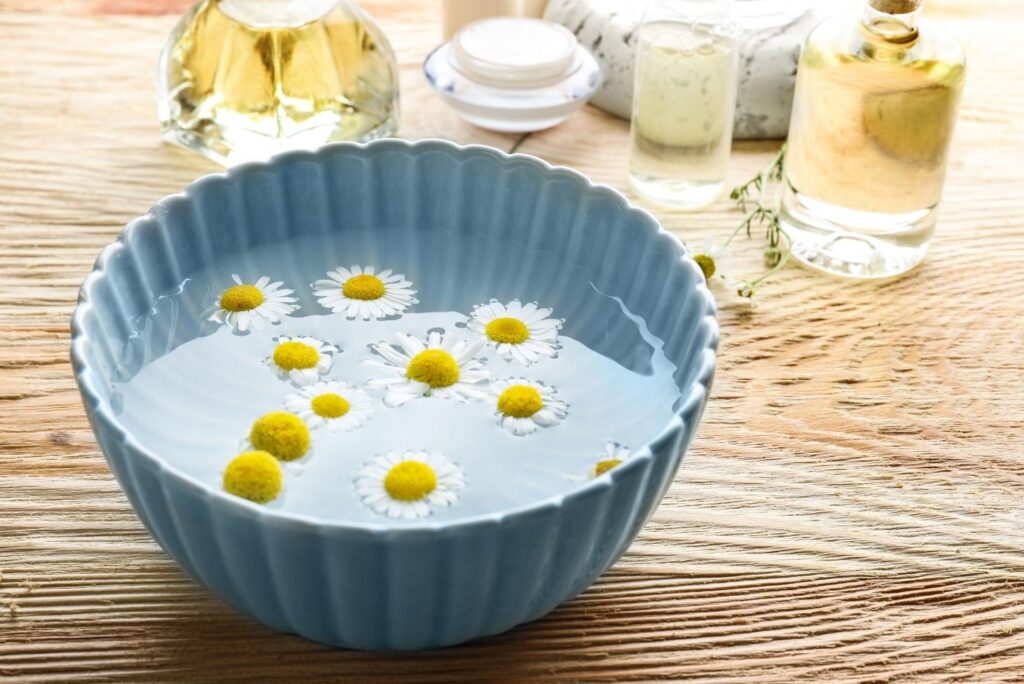
7. Chamomile Bag Sachets for Pain Relief
This is how to make chamomile-filled sachets at home. Fill up a small linen sachet bag with dried chamomile flowers. Stitch up the bag roughly so that the flowers won’t come out. Heat up the chamomile sachet well in a pan over the fire. Apply topically on the painful area.
8. Chamomile Wine Maceration for Kidney Health
This is how to make chamomile wine maceration at home. Soak 30 g dried chamomile in 1 l of organic red wine. Chamomile macerate in wine is good for:
- preventing and reducing kidney stones
- regulating menstruation
- stomach cramps
- dysentery
This remedy also neutralizes the harmful effects of snakebites.
9. Chamomile Cold Maceration for Peptic Ulcers
Among the most amazing chamomile uses is the cold maceration for peptic ulcers. This is how to make chamomile cold maceration at home. Add 2-3 tbsp chamomile flowers in 1/2 L of cold water. Leave the chamomile flowers to soak overnight. The next morning, strain the tea and use the flowers again, this time by pouring 1/2 l of hot water over them. Cover and let it cool off. Strain the second tea and mix the two teas together. Drink this combined chamomile tea over the course of a day. Have this tea instead of water, preferably.

10. Chamomile Tincture for Gastritis
Chamomile tincture is amazing for stomach problems, especially gastritis, and poor digestion, and is among the most popular chamomile uses. This remedy is also great for UTIs. This is how you can make chamomile tincture at home.
- Macerate 1 tablespoon of dried chamomile flowers is left to macerate in 100 ml 70-degree alcohol, for 1 week.
- Strain the tincture and pour it into dark color bottles.
- Store in the refrigerator.
- Have 15 drops, and put in a quarter glass of water, after the main meals.

5 Chamomile Benefits for Skin with Recipes
Chamomile is a skin-nourishing and repair powerhouse, this is why it is very frequently used in beauty products and cosmetics. The most important chamomile uses for skin care are:
- skin repair
- skin nourishing
- moisturizing
- deep skin cleanser
- skin tonic
Here are a few simple DIY chamomile skin cosmetics, with exact recipes.
1. Chamomile Cleansing Milk Recipe
Ingredients
- 1 cup of water
- 1 tbsp honey
- 120 ml full-fat cow’s milk
- 1 egg yolk
- 40 drops of concentrated chamomile tea
Preparation
Make the concentrated chamomile tea by boiling 4 heaped tablespoons of the plant in 1 cup of water). Meanwhile, warm up the water and add the honey. Stir continuously. Let the honey water cool off a bit and then gradually add the milk, whisked egg yolk, and 40 drops of chamomile concentrate. Mix very well. Pour the cleansing milk into a glass bottle and keep it in the fridge.

2. Chamomile Glowing Skin Mask DIY
Ingredients
- 2 tbsp honey
- 2 tbsp chamomile infusion
Preparation
Mix the honey and the chamomile infusion until you get a homogenized, thin paste. Apply the paste to the face and let it sit for 10-15 minutes. Make this chamomile face mask more effective and apply it right after a shower. The bath steam opens the pores and allows the beneficial goodies in the mask to deeply penetrate the skin. The glowing and toning effects of this mask are visible right away.
3. Chamomile Homemade Skin Moisturizer
Ingredients
- 1 medium-sized cucumber
- 1 tbsp dried chamomile flowers
- 2 tbsp glycerin
- 600 ml water
Preparation
Juice the cucumber using a slow juicer to preserve the antioxidants. Add 1 cup of how water over the chamomile to make a tea. Let the tea steep for 20 minutes. When the tea is lukewarm, add in the glycerin and the cucumber juice and mix very well. Pour the skin moisturizer into a glass bottle. As with every homemade cosmetic, the chamomile skin moisturizer needs to be stored in the fridge. The shelf life of this moisturizer is 10 days. Use it to moisturize your skin after cleansing it thoroughly. This skin moisturizer makes your skin velvety, glowy, and fresh. It is a perfect moisturizer for all skin types.

4. Chamomile Makeup Removal DIY
Ingredients
- 50 ml full-fat cow’s milk
- 2 tablespoons chamomile flowers.
Preparation
Heat up milk, and when it starts to boil add the chamomile flowers. Let it simmer on very low heat, and stir continuously for 15 minutes. Do not let it boil. Infuse for 2 hours, then strain. You can store the chamomile makeup removal in the refrigerator for 2-3 days.
5. Hydrating Chamomile Face Cream Recipe
Ingredients
- 1 handful of chamomile flowers (dried)
- 100 ml sweet almond oil
- 20 g beeswax
Preparation
Put the chamomile flowers in a glass jar and pour the oil over gently, until they are fully covered. Close the jar tightly and leave it for six weeks in a warm, sunny place. Strain the oil through a (coffee) filter into a glass bowl, add the beeswax, and put the bowl on bain-marie. Mix continuously until the wax melts completely, but is not overheated. Pour the liquid mixture into a glass container. For best effects, apply the chamomile face cream in the morning and evening, by gently massaging it into the skin.
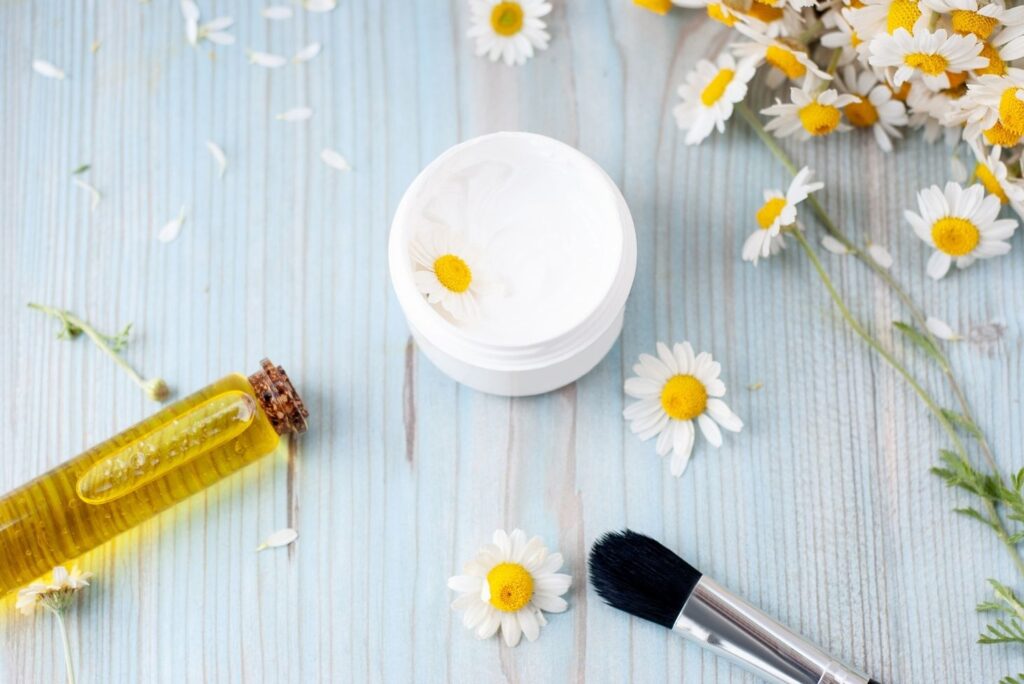
3 Chamomile Uses for Hair & Body with Recipes
1. Natural Chamomile Shampoo for Blond Hair
Ingredients
- 1 hand full of fresh chamomile flowers
- 3/4 l distilled water
- 50 g grated glycerin soap
- 50 g chamomile tincture
Preparation
Put the chamomile flowers in a ceramic or glass bowl and pour over 1 cup of the boiled hot water. Cover the pot and leave to infuse for 3 hours. Strain by pressing down on the flowers well. Boil the remaining water with the glycerin soap for 10 minutes. Allow it to cool off and then mix it with the chamomile infusion. Add the chamomile tincture. Pour the chamomile shampoo into a bottle and shake well.
This chamomile shampoo highlights the natural blond tones in fair hair. In addition, it cleanses the hair and scalp thoroughly. Rinse with water and lemon juice, in a 1:1 ratio. If you want to lighten up the color of your hair naturally, this natural chamomile shampoo is exactly what you need.

2. Hydrating Chamomile Bath
Ingredients
- 4 tbsp chamomile dried flowers
- 500 ml of full-fat milk
- 150 g ground oatmeal
Preparation
Pour the milk over the chamomile and leave it to soak overnight in the refrigerator. The next day, strain it through a piece of gauze, directly into your bathwater. Add the powdered oatmeal to your bath water too. Bathe for 15 minutes, then wrap a towel without whipping off the water. Apply a natural skin moisturizer on the body while still wet, to help the skin retain all that good hydration.

3. Chamomile Body Scrub DIY
Ingredients
- 200 g oat flakes
- 75 g almonds
- 2 tablespoons dried lavender flowers
- 1 tablespoon dried mint
- 1 tablespoon dried chamomile
- 60 g cosmetic clay
- plain water
Preparation
Grind the oatmeal using the coffee grinder, then the almonds, and finally the dried plants. Mix them well until you get a homogeneous powder. Add the clay powder to the composition and mix it again. Put body scrub in a jar and keep it in the fridge. This natural body scrub is easy to use. Take 1 teaspoonful of scrub and mix with as much water to obtain a thick paste. Apply this paste to your skin and massage it with your fingers, in circular motions. Let the scrub on your skin for 20 minutes, then rinse thoroughly with warm water. Used daily, the chamomile face and body scrub clears the pores and makes the skin smoother and firmer.
Read Also: 7 DIY Natural Skincare Recipes with Chamomile
Chamomile Side Effects
There are no side effects related to chamomile that we know of. The only drawback is that the body gets used to it easily and thus it can lose its healing qualities if used for extended periods of time.
Chamomile, The One-Herb-Heals-All
Needless to say, chamomile is one of nature’s miracle herbs. There are so many uses for chamomile and health benefits that we can’t express how important this herb is for natural medicine.
Chamomile flowers symbolize energy, true attachment, and devotion
They are modest, yet joyful and happy to serve anyone who needs a remedy. In European superstitions, chamomile flowers are associated with the sun and water. They were used in magical rituals for money, love, inner peace, sleep, and purification. Egyptians had such great respect for chamomile that they worshiped its flowers as deities.
The word chamomile derives from the Greek Chamaimelon that signifies “the apple of the Earth” due to its apple scent.

The shamans of northern Peru used chamomile to chase away the evil spirits, spraying chamomile water from their mouths onto the possessed. In medieval times people believed that taking chamomile helped you attract the person that you love. Even more, they thought chamomile helps you rid of anger and emotional wounds.
In folk beliefs, chamomile flowers were used for their ability to cleanse the negative energies from a home. They used to scatter chamomile flowers in every room of the house, including the windows. Then they swiped off the floors towards the front door and threw out these dark energies.
The planetary sign associated with chamomile is the Sun
Due to his cheerful appearance, pleasant smell, and medical virtues, chamomile is connected to Venus, the goddess of love. Hence, it is a protector of women. The symmetrical golden disk, curved and hollow inside, is very much like the cervix. Words cannot express our true appreciation for the amazing healing virtues of this high vibrational plant. Pick chamomile if you have the change, and witness for yourself the miraculous ways it will benefit your health, mind, and body. Now that you know the most important chamomile uses and health benefits you can start using this herb at home. Stay healthy, naturally!

